Italy is the country of good food, that’s for sure
But you have to be careful of what to eat and where.
Italy is a very diverse country and its regional cuisine reflect the extreme differences that may be found from north to south.
You sure as hell don’t want to eat a pizza in Venezia or a Carbonara in Sicily.
Follow this guide to know the most important regional dishes you can find in most of the italian regions
Italian Cuisine: A Regional Tour
Let’s explore what to eat in Italy’s most visited regions – each with its own distinct culinary identity that reflects local ingredients, history, and traditions:
Tuscany: Rustic Elegance
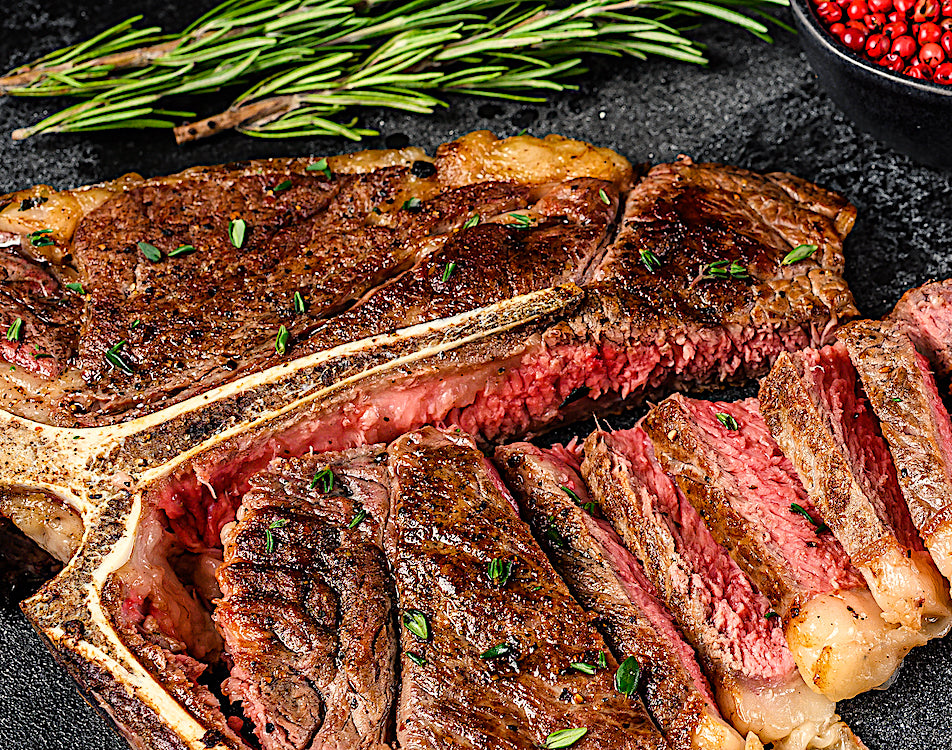
Home to Florence and the rolling hills that have captured travelers’ imaginations for centuries, Tuscany offers rustic, simple cuisine that lets ingredients shine. The Tuscan approach to food embodies the Italian philosophy of quality over quantity, with dishes that reflect the region’s agricultural heritage.
Must-try Tuscan specialties include:
- Bistecca alla Fiorentina: This impressive T-bone steak is grilled over wood or charcoal to rare perfection and seasoned simply with olive oil, salt, and sometimes rosemary.
- Ribollita: A hearty soup made with bread, cannellini beans, kale, and other vegetables – the name means “reboiled,” as it traditionally tastes best when reheated the next day.
- Pappa al Pomodoro: Another bread-based soup with tomatoes, garlic, and basil – the ultimate comfort food.
- Pappardelle al Cinghiale: Wide pasta ribbons served with a rich wild boar sauce.
- Pecorino di Pienza: One of Italy’s finest sheep’s milk cheeses, perfect when paired with local honey.
Tuscany’s wines, from Chianti Classico to Brunello di Montalcino and Vino Nobile di Montepulciano, provide the perfect accompaniment to its rustic cuisine.
For the best food experiences, explore the hilltop towns of Val d’Orcia and the traditional trattorias of Florence’s less touristy Oltrarno district.
Veneto: Aristocratic Flavors
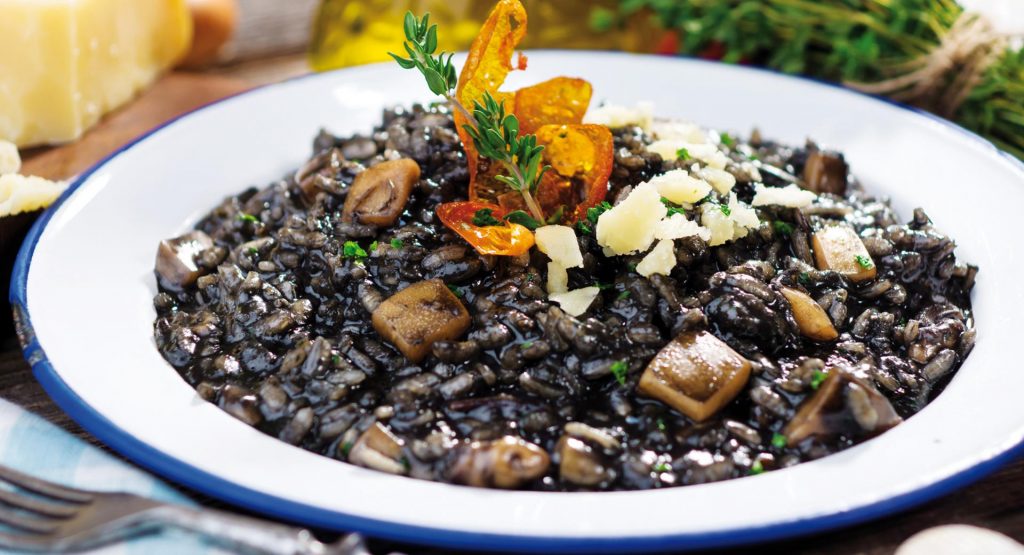
Venice and its surrounding region offer a cuisine reflecting both its lagoon setting and its historic wealth as a maritime power. Veneto’s food is more diverse than many visitors realize, with distinct traditions in its alpine, lowland, and coastal areas.
The Venetian food experience includes:
- Risotto al Nero di Seppia: This striking black risotto gets its color and rich flavor from cuttlefish ink.
- Baccalà Mantecato: Salt cod whipped with olive oil into a creamy spread – try it on grilled polenta for the classic Venetian appetizer.
- Sarde in Saor: Sweet and sour sardines with onions, pine nuts, and raisins – a dish that dates back to when Venetian sailors needed preserved food for long voyages.
- Fegato alla Veneziana: Calf’s liver with onions, a dish that shows Venice’s historic trading connections with the East.
- Cicchetti: Venice’s answer to tapas – small bites typically enjoyed with an ombra (small glass of wine) at traditional bacari (wine bars).
Beyond Venice, don’t miss the radicchio of Treviso, the white asparagus of Bassano del Grappa, and the wine regions of Valpolicella and Soave. The Rialto Market in Venice offers a glimpse into the region’s incredible seafood variety, while the mainland cities of Padua and Verona have their own proud culinary traditions.
Emilia-Romagna: Italy’s Food Valley
Often called Italy’s gastronomic heartland, Emilia-Romagna has given the world some of its most beloved foods. This prosperous northern region stretches from Piacenza to Rimini, with Bologna (“La Grassa” – the fat one) as its culinary capital.
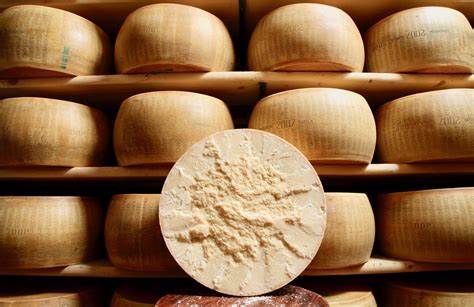
The region’s impressive food credentials include:
- Parmigiano Reggiano: The undisputed king of Italian cheeses, aged for a minimum of 12 months and up to 36+ months for complex flavor.
- Prosciutto di Parma: Sweet, delicate cured ham traditionally served with melon or figs.
- Aceto Balsamico Tradizionale: True traditional balsamic vinegar from Modena and Reggio Emilia, aged for at least 12 years in wooden barrels.
- Tagliatelle al Ragù: The authentic Bolognese sauce served with fresh egg pasta ribbons, never spaghetti.
- Tortellini in Brodo: Small meat-filled pasta dumplings served in a rich capon or beef broth, traditionally eaten on Christmas.
The region’s food markets, like Bologna’s Quadrilatero or Modena’s Mercato Albinelli, are paradise for food lovers. For full immersion, visit producers along the “Food Valley” routes to see Parmigiano being made in copper vats or prosciutto aging in temperature-controlled rooms. For pasta enthusiasts, nothing beats watching sfogline (pasta ladies) roll and cut fresh pasta by hand in Bologna’s traditional pasta shops.
Sicily: Mediterranean Fusion

Sicily’s cuisine is perhaps Italy’s most diverse, reflecting 3,000 years of conquests and cultural exchanges. Arab, Spanish, Greek, and North African influences blend with Italian traditions to create a unique culinary landscape.
Sicilian food highlights include:
- Arancini: Fried rice balls stuffed with ragù, peas, and mozzarella (or numerous other fillings) – the ultimate street food.
- Pasta alla Norma: Pasta with fried eggplant, tomato sauce, basil, and ricotta salata, named after Bellini’s opera.
- Pasta con le Sarde: Bucatini with sardines, wild fennel, pine nuts, raisins, and breadcrumbs – a perfect example of Arab-influenced Sicilian cuisine.
- Caponata: Sweet and sour eggplant relish that demonstrates Sicily’s connection to Arab cuisine.
- Cannoli: Crisp pastry tubes filled with sweetened ricotta, often decorated with candied fruit or chocolate chips – Sicily’s most famous dessert.
The island’s diverse geography means incredible variety, from Palermo’s vibrant street food markets to Catania’s fish markets and Trapani’s salt pans. Sicily’s sweet traditions shine especially bright – try the marzipan fruits (frutta martorana), cassata (ricotta cake), and granita (semi-frozen dessert) with brioche for breakfast on hot summer days. Sicilian wines, from Nero d’Avola to the sweet Marsala, complete the island’s gastronomic picture.
Rome and Lazio: Imperial Simplicity
The eternal city and its surrounding region offer cuisine that embodies the philosophy of “cucina povera” (poor kitchen) – simple ingredients transformed into extraordinary dishes through centuries of culinary wisdom.
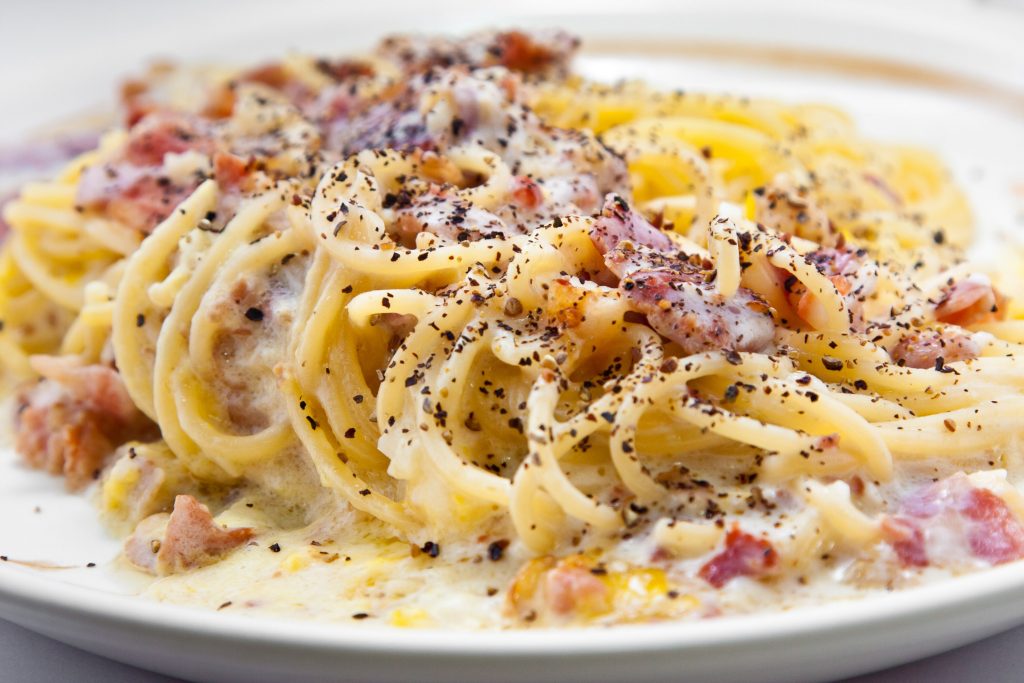
Roman classics include:
- Cacio e Pepe: Perhaps the ultimate simple pasta – just spaghetti with pecorino romano cheese and black pepper, requiring perfect technique to create the creamy sauce.
- Carbonara: Rigatoni or spaghetti with egg, pecorino, guanciale (cured pork jowl), and black pepper – no cream, ever!
- Amatriciana: Tomato-based pasta sauce with guanciale and pecorino, originating from the town of Amatrice.
- Carciofi alla Giudia: Jewish-style artichokes fried to golden perfection – the ultimate Roman spring delicacy.
- Saltimbocca alla Romana: Veal cutlets with prosciutto and sage, literally meaning “jump in the mouth” for their irresistible flavor.
Rome’s famous quinto quarto (fifth quarter) cuisine – offal dishes like tripe, oxtail, and sweetbreads – reflects the city’s history, when slaughterhouse workers were paid partly with these less desirable cuts. For authentic experiences, escape the tourist centers and head to neighborhoods like Testaccio (Rome’s original slaughterhouse district) or Trastevere. The Jewish Ghetto offers its own culinary traditions that have become integral to Roman cuisine.
Naples and Campania: Where Passion Meets the Plate
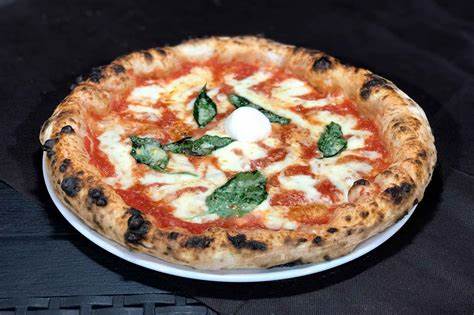
Naples and the surrounding Campania region offer a cuisine where passion, tradition, and extraordinary ingredients create magic on the plate. The fertile volcanic soil around Mount Vesuvius produces intensely flavored tomatoes, vegetables, and fruits, while the Bay of Naples provides abundant seafood.
Pizza: A World Heritage
Naples is the undisputed birthplace of pizza, now recognized by UNESCO as an Intangible Cultural Heritage. A true Pizza Napoletana features a soft, pillowy crust with a raised edge (cornicione), minimal but high-quality toppings, and quick cooking (60-90 seconds) in a blazing hot wood-fired oven (around 485°C/905°F).
The classic varieties remain the simplest:
- Marinara: Just tomato, garlic, oregano, and olive oil – no cheese.
- Margherita: Tomato, mozzarella, basil, and olive oil, representing the colors of the Italian flag.
Where to try authentic pizza:
- L’Antica Pizzeria da Michele: Dating from 1870 and featured in “Eat Pray Love,” this institution serves only Marinara and Margherita, focusing on perfection.
- Sorbillo: Gino Sorbillo has become a global ambassador for Neapolitan pizza, with his original location on Via dei Tribunali remaining a pilgrimage site.
- Da Attilio: Known for innovative touches like the star-shaped pizza and the montanara (fried pizza).
Mozzarella: The Undisputed Queen of Cheeses
While Parmigiano Reggiano may claim the title of king of cheeses with its complexity, aging process and prestige, Buffalo Mozzarella from Campania is undoubtedly the queen of the dairy world. This white jewel born in the plains between Naples and Caserta boasts an unparalleled consistency: a silky exterior that holds a soft heart releasing sweet milk with every bite. True DOP buffalo mozzarella is a complete sensory experience – the milky aroma, the elastic texture that “strings” when you tear it, and that delicate yet distinctive flavor that no other cheese in the world can replicate.
Unlike the king Parmigiano that requires patience and aging, queen Mozzarella celebrates immediate freshness, reminding us that true Italian gastronomic excellence exists both in the present moment and in centuries-old tradition.
To enjoy mozzarella at its finest, eat it within 24 hours of production, slightly warm, accompanied only by a drizzle of olive oil and perhaps a Vesuvius tomato – and you’ll understand why this Campanian wonder reigns supreme on tables around the world.
Street Food: Naples’ Open-Air Feast
Naples offers some of Italy’s best street food, with countless friggitorie (fry shops) and street vendors selling affordable delicacies:
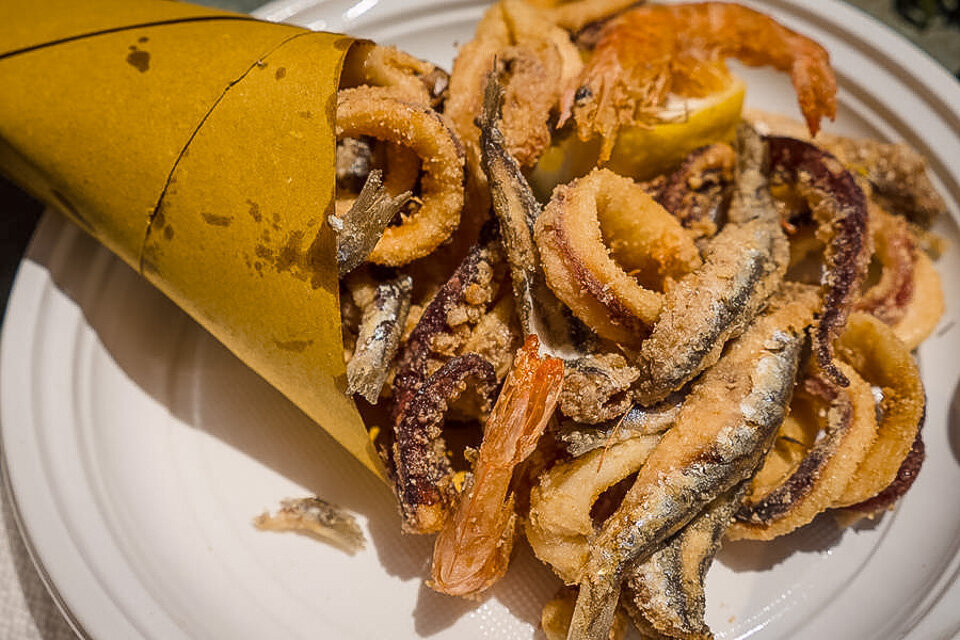
- Cuoppo: A paper cone filled with assorted fried goodness – from zeppoline (small dough balls) to seafood and vegetables.
- Pizza a Portafoglio: A folded pizza “wallet” designed to be eaten on the go.
- Frittatina di Pasta: A breaded and fried pasta cake filled with béchamel, peas, meat ragu, and cheese.
- Pizza Fritta: The iconic fried calzone, with ragù, ricotta, and ciccioli (pork bits) sealed inside dough and deep-fried.
For the best street food experience, wander around Via dei Tribunali and the Spanish Quarter, where locals and visitors alike enjoy these portable treats.
Pasta: Beyond the Basics
Naples has given the world several iconic pasta dishes:
- Ragù Napoletano: Unlike its northern counterpart, this meat sauce simmers for hours with large cuts of meat rather than minced meat. The sauce goes with the pasta, while the tender meat becomes a separate second course.
- Pasta e Patate: Seemingly simple pasta with potatoes becomes extraordinary with the addition of provola cheese and often pancetta.
- Pasta alla Genovese: Despite its name, this is a Neapolitan classic featuring pasta with an onion-based sauce that slow-cooks until caramelized.
The Sweet Side of Naples
Neapolitan pastry traditions are equally impressive:
- Sfogliatella: This shell-shaped pastry comes in two varieties – riccia (flaky) and frolla (shortcrust) – both filled with sweet ricotta, semolina, and candied fruit.
- Babà: The rum-soaked sponge cake arrived from France but was perfected in Naples.
- Pastiera Napoletana: This Easter wheat and ricotta pie scented with orange flower water represents Naples’ most iconic dessert.
For the best pastries, try historic establishments like Scaturchio near Piazza San Domenico Maggiore or join the queue at Attanasio near the central station for fresh sfogliatelle.
Coffee: A Ritual and Religion
Neapolitan coffee culture deserves special mention. The local espresso is strong, intensely flavored, and served in tiny cups, often with a glass of water on the side. The caffè sospeso (suspended coffee) tradition – where customers pay for an extra coffee for someone in need – exemplifies the city’s generous spirit.
Northern Italian Alps: Alpine Traditions
The Alpine regions of Italy – including Valle d’Aosta, Trentino-Alto Adige, and parts of Lombardy and Piedmont – offer cuisine heavily influenced by their mountain setting and proximity to France, Switzerland, and Austria.
Alpine specialties include:
- Fontina and Raclette: Melted cheese dishes perfect after a day in the mountains.
- Polenta Concia: Cornmeal polenta enriched with mountain cheeses.
- Pizzoccheri: Buckwheat pasta with potatoes, cabbage, and cheese from the Valtellina region.
- Canederli/Knödel: Bread dumplings reflecting the Austrian influence.
- Speck: The distinctive smoked, cured ham of the South Tyrol.
The mountain regions offer excellent game dishes, mushrooms (especially porcini), and berries in season. The wines of these regions, from Valle d’Aosta’s crisp whites to Alto Adige’s aromatic varieties, deserve special attention.
Puglia: The Breadbasket of Italy
The heel of Italy’s boot offers cuisine centered around exceptional olive oil, vegetables, and durum wheat. Pugliese cooking embodies the Mediterranean diet at its most authentic.
Don’t miss these Pugliese specialties:
- Orecchiette con Cime di Rapa: Ear-shaped pasta with turnip tops, garlic, anchovies, and chili.
- Burrata: The creamier cousin of mozzarella, with a solid outer layer and soft, creamy interior.
- Fave e Cicoria: Fava bean purée with wild chicory – a dish dating back to ancient times.
- Pane di Altamura: Bread so special it has its own DOP status, with a crisp crust and yellow crumb.
- Tiella Barese: A casserole of rice, potatoes, and mussels that showcases Puglia’s land and sea ingredients.
For an authentic experience, stay in a masseria (fortified farmhouse) where you can taste olive oil, cheese, and wine produced on-site. The coastal towns offer excellent seafood, often served raw or simply grilled.
How to Eat Like a Real Italian
To truly experience authentic Italian food culture, follow these local customs:
- Respect meal times – Lunch typically runs from 1-3 PM and dinner from 8-10 PM. Arriving at 7 PM for dinner marks you as a tourist.
- Understand the courses – A full Italian meal follows the structure of antipasto, primo (pasta/rice), secondo (meat/fish) with contorno (vegetable side), and dolce. You don’t need to order every course, but respect the sequence.
- Don’t rush – Meals are social events, not just refueling stops. Two hours for lunch is perfectly normal.
- Coffee rules – Cappuccino is a breakfast drink only, never after meals. Espresso is drunk quickly at the bar, not lingered over.
- Cheese etiquette – Never ask for cheese on seafood pasta – it’s considered culinary sacrilege throughout Italy.
⚠️ Important Tips for Food Tourists ⚠️
- Be skeptical of tourist menus – Restaurants with picture menus or “tourist menu” signs are rarely the best choices.
- Check the bread charge – The “coperto” (cover charge) is normal, but should be reasonable (3-5 euros maximum).
- Verify prices before ordering – Especially with seafood, which can be priced by weight.
- Look for the locals – If a place is full of Italians (especially families or older people), you’ve found somewhere authentic.
- Regional over national – Remember that Italians think of their cuisine regionally, not nationally. Ask for local specialties rather than generic “Italian food.”
Conclusion: Italy’s Culinary Soul
Italian cuisine is a mosaic of regional traditions, each with its own unique character reflecting geography, history, and cultural exchanges. From the alpine flavors of the north to the Mediterranean influences of the south, every region offers distinctive tastes worth exploring.
While Rome, Bologna, and Milan all have their culinary merits, Naples stands as one of Italy’s most vibrant food destinations. Its cuisine remains deeply connected to local ingredients, traditions, and the daily rhythms of life rather than catering primarily to tourism.
The next time you’re planning an Italian food tour, consider exploring beyond the obvious destinations. Stay a while in Naples, venture into Puglia’s olive groves, or discover the Alpine flavors of Trentino. Italy’s food landscape rewards the curious traveler willing to explore beyond the familiar.
As Italians say: “A tavola non si invecchia” – At the table, one doesn’t age. In Italy, at the table, one lives.
⚠️ Disclaimer ⚠️
The information provided in this article is based on local knowledge and personal experiences. Restaurant quality can vary, and establishments may close or change. Always check recent reviews and opening hours before visiting.

Leave a Reply